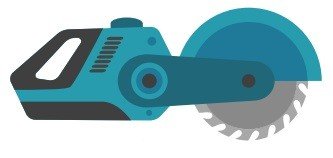The 10 Most Terrifying Things About Shop Power Tools
페이지 정보

본문
The Workhorse of the Shop Power Tools
Hand-held power tools are powered by internal combustion, electricity, or compressed air. They may be used for cutting, drilling or sanding the material.
 One of the most important power tools online tools that every woodworker must have is a tablesaw which can take care of nearly any cutting task. Also, consider a miter saw stand and a drill/driver set.
One of the most important power tools online tools that every woodworker must have is a tablesaw which can take care of nearly any cutting task. Also, consider a miter saw stand and a drill/driver set.
Table Saw
A table saw is the mainstay of the shop power tools, and is perhaps the most versatile woodworking tool. It can rip stock and cross-cut it, slit it, miter it and even dado or rabbet it. It can also cut angled surfaces to make frames, chests, or planters.
The circular blade of the saw is large and rotates at high speed. It has fairly large tables (infeed and outfeed) that help support the wood as it moves through the blade. The saw blade is guarded by guards for the blade that help prevent the wood from being caught and possibly being kicked back at the operator. The saw is further protected by a splitter, or cutting blade. This is a vertical extension directly behind the blade, and may take the shape of a fin or pin.
Table saws designed for contractors feature a larger motor that hinges to the rear of the saw and drives the blade using two or three rubber V-belts. They are typically used by carpenters, however they are also found in home shops. They have more features, like an adjustable mitertable that slides, and are more durable than portable ones.
Table saws that are smaller come with a lighter motor, which is usually belt-driven. These saws are more geared towards hobbyists and domestic use. A lot of them have a sliding miter table which allows the user to cut intricate cuts, such as those for mirror and picture frames, boxes, cases and drawers.
It is crucial to operate the tablesaw in a safe manner to avoid injuries. Always remain to the left of the blade when performing cuts that rip and ensure that your hands are away from the edge of the saw. It is essential to utilize a push stick or guide block when cutting, especially in business settings where HSE standards require that you keep at least an arm's length away from the blade.
A simple adjustable tapering tool that you could create yourself is the fastest and most simple method to cut tapered legs for a variety of woodworking projects. A tapering jig is adjusted for any angle between 0 and 15 degrees, allowing you to cut any set of tapered legs for furniture like cabinets or tables in your shop.
Bandsaw
A bandsaw is ideal to cut various shapes from metal and wood making it an essential tool for custom fabrication. It's also a valuable tool for cabinetry, furniture construction and other woodworking projects. The saw is able to create curved cuts including circles, and can cut through various kinds of materials, including ice.
There are two main kinds of bandsaws: horizontal and horizontal. Vertical bandsaws are great at resawing, curved cuts and freehand cutting. Horizontal bandsaws provide a more straight and angled cuts. The saw can be operated manually or through a powered feed system. Manual bandsaws require that the user manually lower and raise the blade after each cut. Power tool Products-fed systems are more efficient.
Safety is the top priority when working with a bandsaw. Wear protective equipment, such as safety goggles or ear protection, to protect yourself from noise and sawdust. To prevent accidents and injuries keep your hands and feet clear of the blade. It is also essential to set up the saw properly to ensure safe operation. Make sure that the blade and guides are aligned and that the blade is secured.
Depending on the type of material you're cutting, you might need to adjust the feed rate and speed to get the best results. Regular maintenance, including adjustments to the tension and tracking of the blade will ensure that your bandsaw makes precise and clean cuts and extends its life.
The blade of a bandsaw is likely to be made of heat-treated stainless steel in order to resist wear and tear that comes with regular use. The teeth of the saw are joined together to give it a unique shape and protecting against damage from the sudden impact.
The throat depth of bandsaws determines the length of a piece of wood it can cut. The larger throat depths permit you to cut larger pieces of lumber and are also helpful for resawing or ripping, which are both techniques that involve cutting across the grain. Some bandsaws feature tilting tables that can be used to make cut angles and reuse scrap wood.
Dust Collector
Woodworking electrical tools online create a lot of dust and chips, which need to be removed to protect your health as well as keep your shop clean. shop as well as the durability of your equipment. The type of collector you require will depend on the size and number of power tools that you use in your woodshop as in the frequency of their use. The top woodworking dust collectors offer superior filtering that removes fine particles from the air, allowing you to breathe healthier, cleaner and more comfortable while you work.
Whether you have a small one-man shop or a large production woodworking facility, Nederman has dust collection systems that meet your needs. Our woodworking dust management, waste management and combustible-dust management solutions combine environmental protection with increases in the productivity of machines.
There are several types of woodshop dust collectors available on the market including:
A basic dust extractor can replace your shop vacuum. These units are connected to your power tool using an hose that connects to the dust port. The hose is activated when you switch on the tool and pulls dust and debris out of your workspace.
Depending on the model you choose, most dust extractors come with HEPA filters to effectively remove the fine dust particles that can lead to respiratory issues over time. They also usually feature a higher CFM (cubic feet per minute) airflow, which allows for an increased amount of air. They could also have an indicator of airspeed and a system which automatically cleans the filters.
If you own a larger shop or prefer the flexibility to use your woodworking tools on the go, consider a portable woodshop dust collector with an rechargeable battery as well as a plug-in connection that connects directly to an electric tool. They are easy to transport and can handle multiple tools at a time. They are small and feature a caster-base. They also come with bags or a filter for collection for easy emptying.
If you're a skilled woodworker or https://bogazicitente.com/ contractor, you might require a stronger dust collection system. These units are more expensive than extractors, but they provide a wider range of filtration. They can also be hung on a wall or even in their own room. These units can be used to clean up drywall, plaster and other demolition projects as well as woodworking projects.
Planer
The planer is a powerful tool that every woodshop should ever be without. It's not the most glamorous or flashy tool, but it can make a massive difference in the way you transform rough lumber into stunning and useful projects. It is used to take boards down to a specific thickness and works on both softwoods and hardwoods. It can also be useful for working with knotty, unwieldy, or twisted stock which is not possible to handle with hand tools uk online.
A good quality portable planer is worth the cost of admission to any woodworking shop. You may be able to get a bargain on a planer that's slightly used, [empty] but pay particular attention to the condition of the cutter head and tables for infeed and outfeed. These items will determine the performance of your planer, and whether it will last for a long period before you have to replace the parts. If the cutter head isn't of a high quality it will quickly wear down and you might need to replace it in the shortest amount of time.
Many people confuse the planer and a jointer, but they are not the same machine. The jointer produces a piece of wood flat and straight, while the plane cuts it to a certain thickness. Some woodworkers utilize both machines at once to finish an assignment. But, they're essential to any workshop that handles rough lumber on a daily basis.
A commercial-grade planer is a great investment if you want to work with wood professionally and are looking for reliable equipment. These are built to run in situations where speed of production is more important than finishing the surface. These machines can help you save time but you will need to be very careful not to overload them as they may burn out. They should also be maintained properly to ensure that they function correctly. A routine of regular maintenance in the shop can help prolong the life of your planer.
Hand-held power tools are powered by internal combustion, electricity, or compressed air. They may be used for cutting, drilling or sanding the material.
 One of the most important power tools online tools that every woodworker must have is a tablesaw which can take care of nearly any cutting task. Also, consider a miter saw stand and a drill/driver set.
One of the most important power tools online tools that every woodworker must have is a tablesaw which can take care of nearly any cutting task. Also, consider a miter saw stand and a drill/driver set.Table Saw
A table saw is the mainstay of the shop power tools, and is perhaps the most versatile woodworking tool. It can rip stock and cross-cut it, slit it, miter it and even dado or rabbet it. It can also cut angled surfaces to make frames, chests, or planters.
The circular blade of the saw is large and rotates at high speed. It has fairly large tables (infeed and outfeed) that help support the wood as it moves through the blade. The saw blade is guarded by guards for the blade that help prevent the wood from being caught and possibly being kicked back at the operator. The saw is further protected by a splitter, or cutting blade. This is a vertical extension directly behind the blade, and may take the shape of a fin or pin.
Table saws designed for contractors feature a larger motor that hinges to the rear of the saw and drives the blade using two or three rubber V-belts. They are typically used by carpenters, however they are also found in home shops. They have more features, like an adjustable mitertable that slides, and are more durable than portable ones.
Table saws that are smaller come with a lighter motor, which is usually belt-driven. These saws are more geared towards hobbyists and domestic use. A lot of them have a sliding miter table which allows the user to cut intricate cuts, such as those for mirror and picture frames, boxes, cases and drawers.
It is crucial to operate the tablesaw in a safe manner to avoid injuries. Always remain to the left of the blade when performing cuts that rip and ensure that your hands are away from the edge of the saw. It is essential to utilize a push stick or guide block when cutting, especially in business settings where HSE standards require that you keep at least an arm's length away from the blade.
A simple adjustable tapering tool that you could create yourself is the fastest and most simple method to cut tapered legs for a variety of woodworking projects. A tapering jig is adjusted for any angle between 0 and 15 degrees, allowing you to cut any set of tapered legs for furniture like cabinets or tables in your shop.
Bandsaw
A bandsaw is ideal to cut various shapes from metal and wood making it an essential tool for custom fabrication. It's also a valuable tool for cabinetry, furniture construction and other woodworking projects. The saw is able to create curved cuts including circles, and can cut through various kinds of materials, including ice.
There are two main kinds of bandsaws: horizontal and horizontal. Vertical bandsaws are great at resawing, curved cuts and freehand cutting. Horizontal bandsaws provide a more straight and angled cuts. The saw can be operated manually or through a powered feed system. Manual bandsaws require that the user manually lower and raise the blade after each cut. Power tool Products-fed systems are more efficient.
Safety is the top priority when working with a bandsaw. Wear protective equipment, such as safety goggles or ear protection, to protect yourself from noise and sawdust. To prevent accidents and injuries keep your hands and feet clear of the blade. It is also essential to set up the saw properly to ensure safe operation. Make sure that the blade and guides are aligned and that the blade is secured.
Depending on the type of material you're cutting, you might need to adjust the feed rate and speed to get the best results. Regular maintenance, including adjustments to the tension and tracking of the blade will ensure that your bandsaw makes precise and clean cuts and extends its life.
The blade of a bandsaw is likely to be made of heat-treated stainless steel in order to resist wear and tear that comes with regular use. The teeth of the saw are joined together to give it a unique shape and protecting against damage from the sudden impact.
The throat depth of bandsaws determines the length of a piece of wood it can cut. The larger throat depths permit you to cut larger pieces of lumber and are also helpful for resawing or ripping, which are both techniques that involve cutting across the grain. Some bandsaws feature tilting tables that can be used to make cut angles and reuse scrap wood.
Dust Collector
Woodworking electrical tools online create a lot of dust and chips, which need to be removed to protect your health as well as keep your shop clean. shop as well as the durability of your equipment. The type of collector you require will depend on the size and number of power tools that you use in your woodshop as in the frequency of their use. The top woodworking dust collectors offer superior filtering that removes fine particles from the air, allowing you to breathe healthier, cleaner and more comfortable while you work.
Whether you have a small one-man shop or a large production woodworking facility, Nederman has dust collection systems that meet your needs. Our woodworking dust management, waste management and combustible-dust management solutions combine environmental protection with increases in the productivity of machines.
There are several types of woodshop dust collectors available on the market including:
A basic dust extractor can replace your shop vacuum. These units are connected to your power tool using an hose that connects to the dust port. The hose is activated when you switch on the tool and pulls dust and debris out of your workspace.
Depending on the model you choose, most dust extractors come with HEPA filters to effectively remove the fine dust particles that can lead to respiratory issues over time. They also usually feature a higher CFM (cubic feet per minute) airflow, which allows for an increased amount of air. They could also have an indicator of airspeed and a system which automatically cleans the filters.
If you own a larger shop or prefer the flexibility to use your woodworking tools on the go, consider a portable woodshop dust collector with an rechargeable battery as well as a plug-in connection that connects directly to an electric tool. They are easy to transport and can handle multiple tools at a time. They are small and feature a caster-base. They also come with bags or a filter for collection for easy emptying.
If you're a skilled woodworker or https://bogazicitente.com/ contractor, you might require a stronger dust collection system. These units are more expensive than extractors, but they provide a wider range of filtration. They can also be hung on a wall or even in their own room. These units can be used to clean up drywall, plaster and other demolition projects as well as woodworking projects.
Planer
The planer is a powerful tool that every woodshop should ever be without. It's not the most glamorous or flashy tool, but it can make a massive difference in the way you transform rough lumber into stunning and useful projects. It is used to take boards down to a specific thickness and works on both softwoods and hardwoods. It can also be useful for working with knotty, unwieldy, or twisted stock which is not possible to handle with hand tools uk online.
A good quality portable planer is worth the cost of admission to any woodworking shop. You may be able to get a bargain on a planer that's slightly used, [empty] but pay particular attention to the condition of the cutter head and tables for infeed and outfeed. These items will determine the performance of your planer, and whether it will last for a long period before you have to replace the parts. If the cutter head isn't of a high quality it will quickly wear down and you might need to replace it in the shortest amount of time.
Many people confuse the planer and a jointer, but they are not the same machine. The jointer produces a piece of wood flat and straight, while the plane cuts it to a certain thickness. Some woodworkers utilize both machines at once to finish an assignment. But, they're essential to any workshop that handles rough lumber on a daily basis.
A commercial-grade planer is a great investment if you want to work with wood professionally and are looking for reliable equipment. These are built to run in situations where speed of production is more important than finishing the surface. These machines can help you save time but you will need to be very careful not to overload them as they may burn out. They should also be maintained properly to ensure that they function correctly. A routine of regular maintenance in the shop can help prolong the life of your planer.
- 이전글See What Mines Gamble Tricks The Celebs Are Using 25.02.27
- 다음글Guide To ADHD In Adults Women: The Intermediate Guide On ADHD In Adults Women 25.02.27
댓글목록
등록된 댓글이 없습니다.




